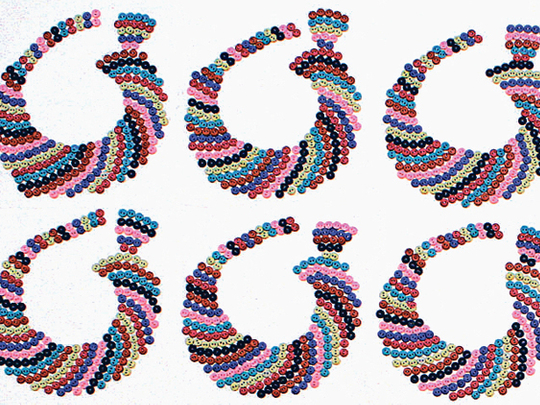
Ever since he can remember, Hakim Ghazali has been obsessed with letters and their artistic representation. The artist from Casablanca is a trained calligrapher and has been experimenting constantly to develop his unique abstract style that is contemporary yet distinctly Moroccan. Although he works with letters, Ghazali does not perceive his work as calligraphy.
"My art goes beyond the letters to explore their deeper meaning as spiritual symbols in Sufi philosophy," he says. In his latest series, titled For the Love of Noon, the artist has focused exclusively on the Arabic letter Noon, a Sufi symbol of femininity and womanhood.
The inspiration for this series came from some old family photographs. "In one of the pictures taken when I was an infant, my mother was holding me in her arms. I noticed that her arm was positioned in the shape of the letter Noon and this connection motivated me to explore the profound meaning of this letter. In Sufi philosophy, this letter, which is shaped like a foetus in the mother's womb, signifies the beauty and warmth of womanhood. So, in essence this work is a homage to my mother and to all mothers," he says.
Ghazali is well-known for the beautiful textures and almost transparent look of his canvases, which he creates by using a mixture of sand, oil, pigments and other materials. But for the first time, he has also experimented with a variety of other materials and techniques such as wood, iron and embroidery. "A woman has so many facets that I had to seek different materials to represent the various aspects of her personality," he says.
The most striking work in the series is a canvas embroidered with gold thread. "I used embroidery because it is traditionally associated with women. While in some areas of this canvas the embroidery is stunningly perfect, there are also areas where I have deliberately left broken stitches and loose threads. This reflects the rough and smooth times in a woman's life and her fortitude through it all," says Ghazali. On another canvas, a series of Noons have been created with buttons, whose many colours reflect the many facets and roles of a woman.
In sharp contrast are Ghazali's monochromatic metal and wood installations. "A woman is soft and docile but she also has great strength and resilience. I have used wood and iron to depict this side of her personality. These wrought iron installations are inspired by the traditional window grilles seen in Moroccan homes but these windows are also a metaphor for the restrictions still imposed on women despite the progress made in modern times," he says.
Ghazali's experiments with new forms of expression are interesting but the true essence of this series lies in Ghazali's signature canvases. The earthy textures, the transparent whites and the delicate, faint lines exude the softness, serenity and purity he perceives in women.
In one painting, the faint Noon drawn with pencil almost merges with the white background. But what stand out are tiny squares of colour painted in a grid within the letter. "These flashes of colour are the happy moments in life and the grid indicates that such moments are few and numbered. But when a woman's soul departs from this world she only leaves behind joyful memories for her loved ones," he says.
Ghazali's voyage of discovery includes a Noon surrounded with an arc, signifying pregnancy and motherhood. Another canvas has two Noons, one representing a worn and tired woman, who still makes the effort to embrace and protect her loved ones, and the other depicting a strong, energetic woman full of life and good cheer. But the centrepiece of the show is a white canvas with no letters. Stuck in the middle of this canvas are two pieces of fabric, with rough edges and cuts that have been patched up. Perhaps this painting is about the woman as a healer, who, though torn and tattered herself, is ever willing to heal the cuts and wounds of others. "This series is a tribute to a woman and her endless giving without expecting anything in return. In this painting, there is no recognisable letter. But I see the two pieces of fabric as Noon and as the woman who is the centre of the world," he says.
Ghazali has been exhibiting in Dubai at the Green Art Gallery since 1996 and is happy that his latest exhibition coincides with the gallery's 15th anniversary.
"This is one of the oldest galleries in Dubai and was among the first to exhibit contemporary Arab art in the city. I was one of the youngest artists that the founder, Myla Atassi, introduced to this market.
"Myla always encouraged me to push the boundaries and gave me the freedom to experiment and evolve. I am happy that her daughter Yasmin has invited me to participate in the celebrations of this important milestone for the gallery. This exhibition is my tribute to Myla, a mother figure who nurtured many young artists like me long before we were well-known and long before Christie's and Sotheby's came to Dubai," he says.
Jyoti Kalsi is a UAE-based art enthusiast.











